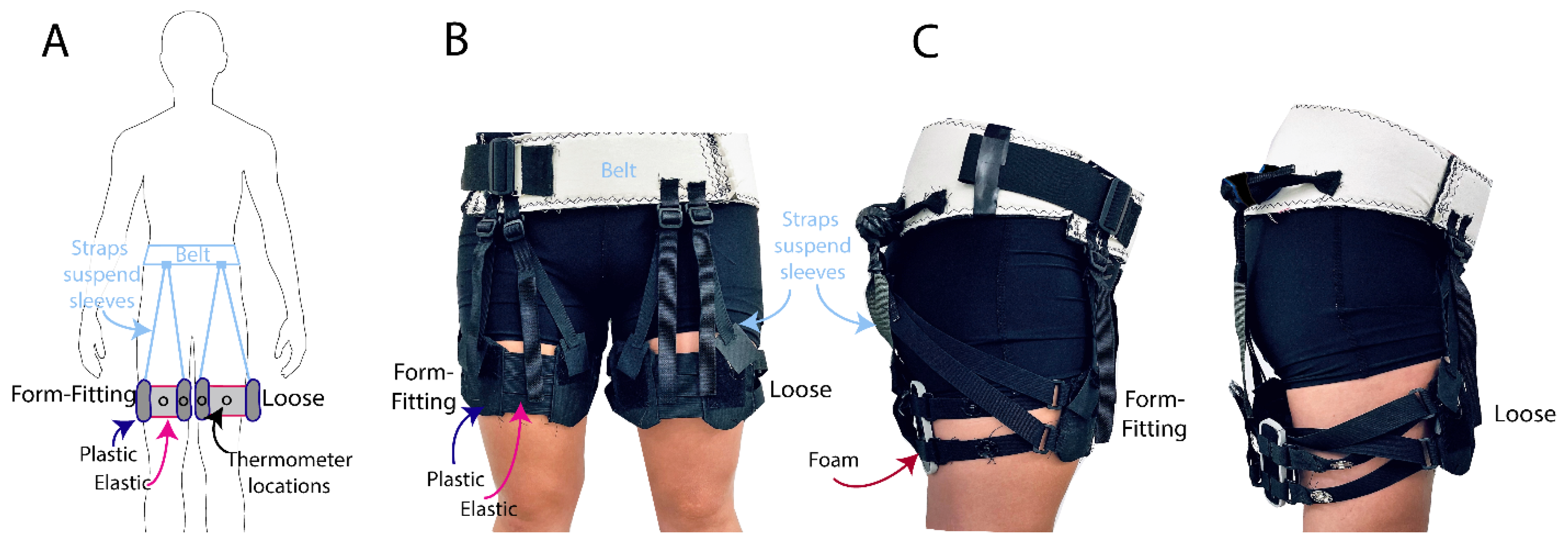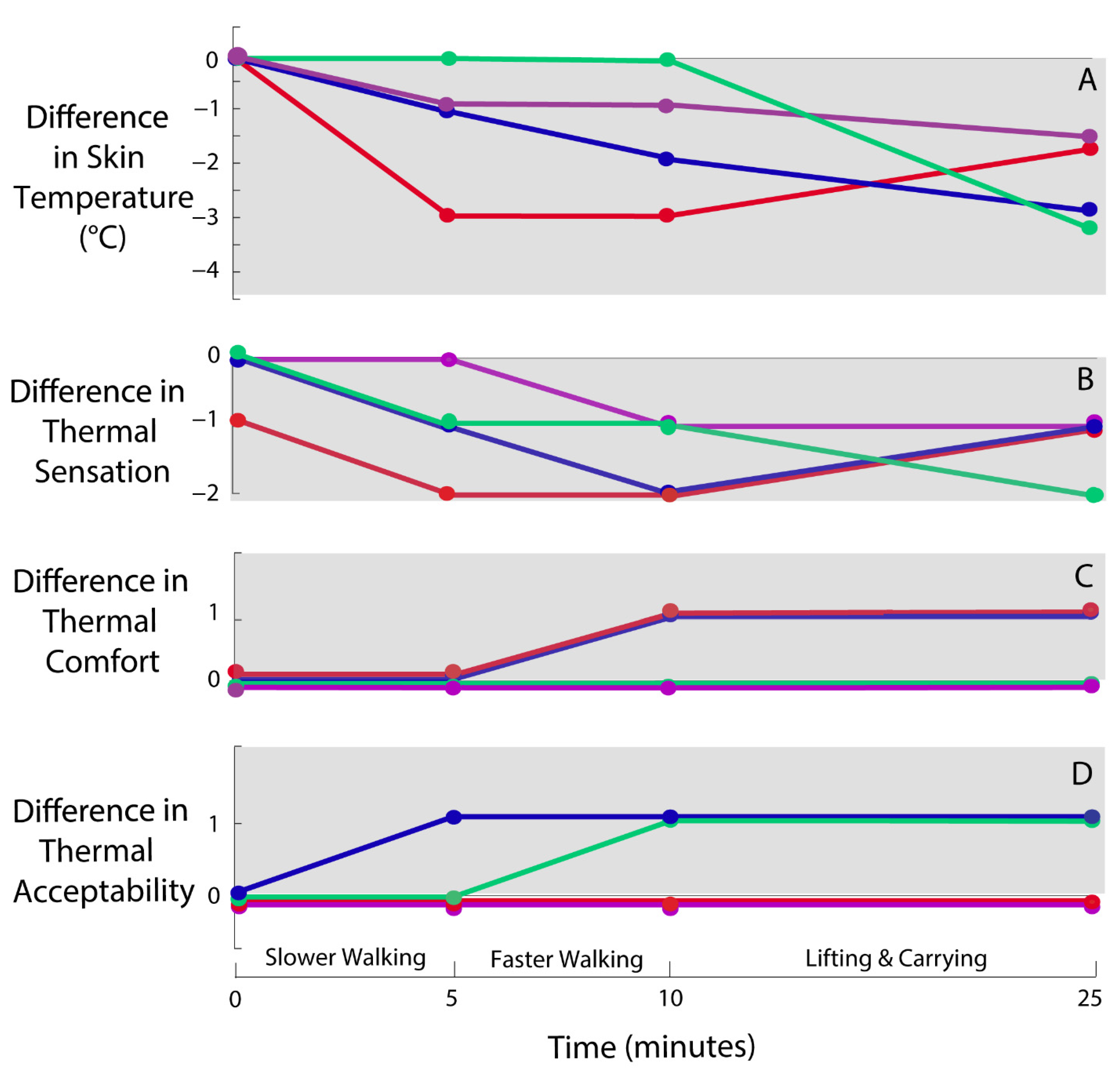Exoskeletons and Exosuits Could Benefit from Mode-Switching Body Interfaces That Loosen/Tighten to Improve Thermal Comfort
Abstract
:1. Introduction
2. Materials and Methods
2.1. Participants
2.2. Leg Sleeve Interfaces
2.3. Skin Temperature
2.4. Subjective Thermal Ratings
2.5. Protocol
2.6. Analysis
3. Results
4. Discussion
5. Conclusions
Author Contributions
Funding
Institutional Review Board Statement
Informed Consent Statement
Conflicts of Interest
References
- Lowe, B.D.; Billotte, W.G.; Peterson, D.R. ASTM F48 Formation and Standards for Industrial Exoskeletons and Exosuits. IISE Trans. Occup. Ergon. Hum. Factors 2019, 7, 230–236. [Google Scholar] [CrossRef] [PubMed]
- Baltrusch, S.J.; van Dieën, J.H.; Koopman, A.S.; Näf, M.B.; Rodriguez-Guerrero, C.; Babič, J.; Houdijk, H. SPEXOR Passive Spinal Exoskeleton Decreases Metabolic Cost during Symmetric Repetitive Lifting. Eur. J. Appl. Physiol. 2020, 120, 401–412. [Google Scholar] [CrossRef] [PubMed] [Green Version]
- Lamers, E.P.; Yang, A.J.; Zelik, K.E. Feasibility of a Biomechanically-Assistive Garment to Reduce Low Back Loading During Leaning and Lifting. IEEE Trans. Biomed. Eng. 2018, 65, 1674–1680. [Google Scholar] [CrossRef] [PubMed]
- Collins, S.H.; Wiggin, M.B.; Sawicki, G.S. Reducing the Energy Cost of Human Walking Using an Unpowered Exoskeleton. Nature 2015, 522, 212–215. [Google Scholar] [CrossRef] [PubMed] [Green Version]
- Huang, J.; Tu, X.; He, J. Design and Evaluation of the RUPERT Wearable Upper Extremity Exoskeleton Robot for Clinical and In-Home Therapies. IEEE Trans. Syst. Man Cybern. Syst. 2016, 46, 926–935. [Google Scholar] [CrossRef]
- Kermavnar, T.; de Vries, A.W.; de Looze, M.P.; O’Sullivan, L.W. Effects of Industrial Back-Support Exoskeletons on Body Loading and User Experience: An Updated Systematic Review. Ergonomics 2021, 64, 685–711. [Google Scholar] [CrossRef] [PubMed]
- Lamers, E.P.; Soltys, J.C.; Scherpereel, K.L.; Yang, A.J.; Zelik, K.E. Low-Profile Elastic Exosuit Reduces Back Muscle Fatigue. Sci. Rep. 2020, 10, 15958. [Google Scholar] [CrossRef] [PubMed]
- Schwartz, M.; Theurel, J.; Desbrosses, K. Effectiveness of Soft versus Rigid Back-Support Exoskeletons during a Lifting Task. Int. J. Environ. Res. Public Health 2021, 18, 8062. [Google Scholar] [CrossRef] [PubMed]
- Yandell, M.B.; Tacca, J.R.; Zelik, K.E. Design of a Low Profile, Unpowered Ankle Exoskeleton That Fits Under Clothes: Overcoming Practical Barriers to Widespread Societal Adoption. IEEE Trans. Neural Syst. Rehabil. Eng. 2019, 27, 712–723. [Google Scholar] [CrossRef]
- Yandell, M.B.; Ziemnicki, D.M.; McDonald, K.A.; Zelik, K.E. Characterizing the Comfort Limits of Forces Applied to the Shoulders, Thigh and Shank to Inform Exosuit Design. PLoS ONE 2020, 15, e0228536. [Google Scholar] [CrossRef]
- Kozinc, Ž.; Babič, J.; Šarabon, N. Human Pressure Tolerance and Effects of Different Padding Materials with Implications for Development of Exoskeletons and Similar Devices. Appl. Ergon. 2021, 93, 103379. [Google Scholar] [CrossRef] [PubMed]
- Stirling, L.; Kelty-Stephen, D.; Fineman, R.; Jones, M.L.H.; Daniel Park, B.-K.; Reed, M.P.; Parham, J.; Choi, H.J. Static, Dynamic, and Cognitive Fit of Exosystems for the Human Operator. Hum. Factors 2020, 62, 424–440. [Google Scholar] [CrossRef]
- Del Ferraro, S.; Falcone, T.; Ranavolo, A.; Molinaro, V. The Effects of Upper-Body Exoskeletons on Human Metabolic Cost and Thermal Response during Work Tasks—A Systematic Review. Int. J. Environ. Res. Public Health 2020, 17, 7374. [Google Scholar] [CrossRef] [PubMed]
- Liu, Y.; Li, X.; Lai, J.; Zhu, A.; Zhang, X.; Zheng, Z.; Zhu, H.; Shi, Y.; Wang, L.; Chen, Z. The Effects of a Passive Exoskeleton on Human Thermal Responses in Temperate and Cold Environments. Int. J. Environ. Res. Public Health 2021, 18, 3889. [Google Scholar] [CrossRef] [PubMed]
- Barrero, M. Integrating Exoskeletons into Manufacturing. In Proceedings of the Automotive Exoskeleton Forum, Phoenix, AZ, USA, 19–28 March 2018. [Google Scholar]
- Benavides, I. Plenary Talk. In Proceedings of the International Symposium on Wearable Robotics, Virtual, 13–16 October 2020. [Google Scholar]
- Song, G.; Mandal, S. 3—Testing and Evaluating the Thermal Comfort of Clothing Ensembles. In Performance Testing of Textiles; Wang, L., Ed.; Woodhead Publishing Series in Textiles; Woodhead Publishing: Shaxton, UK, 2016; pp. 39–64. ISBN 978-0-08-100570-5. [Google Scholar]
- Lamers, E.P.; Zelik, K.E. Design, Modeling, and Demonstration of a New Dual-Mode Back-Assist Exosuit with Extension Mechanism. Available online: https://www.cambridge.org/core/journals/wearable-technologies/article/design-modeling-and-demonstration-of-a-new-dualmode-backassist-exosuit-with-extension-mechanism/4A0D6794537970F885ECE031DD728AA3 (accessed on 13 September 2021).
- Krasny-Pacini, A.; Evans, J. Single-Case Experimental Designs to Assess Intervention Effectiveness in Rehabilitation: A Practical Guide. Ann. Phys. Rehabil. Med. 2018, 61, 164–179. [Google Scholar] [CrossRef] [PubMed]
- ISO 10551 Ergonomics of the Thermal Environment–Assessment of the Influence of the Thermal Environment Using Subjective Judgement Scales; ISO: Geneva, Switzerland, 1995.
- VAVA Smart Baby Thermometer. Available online: https://www.vava.com/products/vava-smart-baby-thermometer (accessed on 13 September 2021).
- Yao, Y.; Lian, Z.; Liu, W.; Shen, Q. Experimental Study on Skin Temperature and Thermal Comfort of the Human Body in a Recumbent Posture under Uniform Thermal Environments. Indoor Built Environ. 2007, 16, 505–518. [Google Scholar] [CrossRef]
- Schweiker, M.; Fuchs, X.; Becker, S.; Shukuya, M.; Dovjak, M.; Hawighorst, M.; Kolarik, J. Challenging the Assumptions for Thermal Sensation Scales. Build. Res. Inf. 2017, 45, 572–589. [Google Scholar] [CrossRef] [Green Version]
- ASHRAE. Thermal Environmental Conditions for Human Occupancy; American Society of Heating, Refrigerating and Air-Conditioning Engineers: Atlanta, GA, USA, 2004; Volume 55. [Google Scholar]
- Bedford, T. The Warmth Factor in Comfort at Work. A Physiological Study of Heating and Ventilation; London H.M.S.O.: London, UK, 1936. [Google Scholar]
- Murtagh, E.M.; Mair, J.L.; Aguiar, E.; Tudor-Locke, C.; Murphy, M.H. Outdoor Walking Speeds of Apparently Healthy Adults: A Systematic Review and Meta-Analysis. Sports Med. 2021, 51, 125–141. [Google Scholar] [CrossRef] [PubMed]
- Matijevich, E.S.; Volgyesi, P.; Zelik, K.E. A Promising Wearable Solution for the Practical and Accurate Monitoring of Low Back Loading in Manual Material Handling. Sensors (Basel) 2021, 21, 340. [Google Scholar] [CrossRef]
- Fisch, G.S. Evaluating Data from Behavioral Analysis: Visual Inspection or Statistical Models? Behav. Process. 2001, 54, 137–154. [Google Scholar] [CrossRef]
- Braun, V.; Clarke, V. Using Thematic Analysis in Psychology. Qual. Res. Psychol. 2006, 3, 77–101. [Google Scholar] [CrossRef] [Green Version]
- Pascoe, D.D.; Bellingar, T.A.; McCluskey, B.S. Clothing and Exercise. II. Influence of Clothing during Exercise/Work in Environmental Extremes. Sports Med. 1994, 18, 94–108. [Google Scholar] [CrossRef]
- Pascoe, D.D.; Shanley, L.A.; Smith, E.W. Clothing and Exercise. I Biophysics of Heat Transfer between the Individual, Clothing and Environment. Sports Med. 1994, 18, 38–54. [Google Scholar] [CrossRef] [PubMed]
- Tanda, G. Skin Temperature Measurements by Infrared Thermography during Running Exercise. Exp. Therm. Fluid Sci. 2016, 71, 103–113. [Google Scholar] [CrossRef]
- Sawka, M.N.; Cheuvront, S.N.; Kenefick, R.W. High Skin Temperature and Hypohydration Impair Aerobic Performance. Exp. Physiol. 2012, 97, 327–332. [Google Scholar] [CrossRef] [PubMed]
- Bartkowiak, G. Influence of Undergarment Structure on the Parameters of the Microclimate under Hermetic Protective Clothingel. Fibres Text. East. Eur. 2010, 81, 82–86. [Google Scholar]
- Gagge, A.P.; Stolwijk, J.A.J.; Saltin, B. Comfort and Thermal Sensations and Associated Physiological Responses during Exercise at Various Ambient Temperatures. Environ. Res. 1969, 2, 209–229. [Google Scholar] [CrossRef]
- Buono, M.J.; Lee, N.V.L.; Miller, P.W. The Relationship between Exercise Intensity and the Sweat Lactate Excretion Rate. J. Physiol. Sci. 2010, 60, 103–107. [Google Scholar] [CrossRef]
- Djongyang, N.; Tchinda, R.; Njomo, D. Thermal Comfort: A Review Paper. Renew. Sustain. Energy Rev. 2010, 14, 2626–2640. [Google Scholar] [CrossRef]
- Wang, Z.; Warren, K.; Luo, M.; He, X.; Zhang, H.; Arens, E.; Chen, W.; He, Y.; Hu, Y.; Jin, L.; et al. Evaluating the Comfort of Thermally Dynamic Wearable Devices. Build. Environ. 2020, 167, 106443. [Google Scholar] [CrossRef]
- Wagoner, R.S.; López-Gálvez, N.I.; de Zapien, J.G.; Griffin, S.C.; Canales, R.A.; Beamer, P.I. An Occupational Heat Stress and Hydration Assessment of Agricultural Workers in North Mexico. Int. J. Environ. Res. Public Health 2020, 17, 2102. [Google Scholar] [CrossRef] [PubMed] [Green Version]
- Bueno, A.M.; de Paula Xavier, A.A.; Broday, E.E. Evaluating the Connection between Thermal Comfort and Productivity in Buildings: A Systematic Literature Review. Buildings 2021, 11, 244. [Google Scholar] [CrossRef]
- Bär, M.; Steinhilber, B.; Rieger, M.A.; Luger, T. The Influence of Using Exoskeletons during Occupational Tasks on Acute Physical Stress and Strain Compared to No Exoskeleton – A Systematic Review and Meta-Analysis. Appl. Ergon. 2021, 94, 103385. [Google Scholar] [CrossRef] [PubMed]
- Zelik, K.E.; Nurse, C.A.; Schall, M.C.; Sesek, R.F.; Marino, M.C.; Gallagher, S. An Ergonomic Assessment Tool for Evaluating the Effect of Back Exoskeletons on Injury Risk. Appl. Ergon. 2022, 99, 103619. [Google Scholar] [CrossRef] [PubMed]
- HFES 400 Committee Human Readiness Level Scale in the System Development Process. 2021. Available online: https://www.hfes.org/Portals/0/Documents/DRAFT%20HFES%20ANSI%20HRL%20Standard%201_2_2021.pdf?ver=2021-01-06-142004-860×tamp=1609964482681 (accessed on 13 September 2021).



| Participant 1 | Participant 2 | Participant 3 | Participant 4 | |
|---|---|---|---|---|
| Baseline | 0 | 1 | 0 | 0 |
| Slower walking | 2 | 1 | 1 | 0 |
| Faster walking | 3 | 1 | 1 | 1 |
| Lifting and carrying | 2 | 1 | 2 | 1 |
| Slower walking (five minutes after loosening sleeve) | −1 | 0 | 1 | 1 |
| Participant 1 | Participant 2 | Participant 3 | Participant 4 | |
|---|---|---|---|---|
| Baseline | 0 | 0 | 0 | 0 |
| Slower walking | 1 | −1 | 0 | 0 |
| Faster walking | 1 | −1 | 0 | 0 |
| Lifting and carrying | 1 | 0 | 0 | 0 |
| Participant 1 | Participant 2 | Participant 3 | Participant 4 | |
|---|---|---|---|---|
| Baseline | 0 | 2 | 0 | 0 |
| Slower walking | 1 | 2 | 0 | 0 |
| Faster walking | −1 | 1 | 0 | 0 |
| Lifting and carrying | −1 | 1 | 0 | 0 |
| Slower walking (five minutes after loosening sleeve) | 0 | 2 | 0 | 0 |
| Participant 1 | Participant 2 | Participant 3 | Participant 4 | |
|---|---|---|---|---|
| Baseline | 0 | 2 | 0 | 0 |
| Slower walking | 1 | 2 | 0 | 0 |
| Faster walking | 0 | 2 | 0 | 0 |
| Lifting and carrying | 0 | 2 | 0 | 0 |
| Participant 1 | Participant 2 | Participant 3 | Participant 4 | |
|---|---|---|---|---|
| Baseline | 1 | 2 | 2 | 2 |
| Slower walking | 0 | 2 | 2 | 2 |
| Faster walking | 0 | 2 | 1 | 2 |
| Lifting and carrying | 0 | 2 | 1 | 2 |
| Slower walking (five minutes after loosening sleeve) | 1 | 2 | 2 | 2 |
| Participant 1 | Participant 2 | Participant 3 | Participant 4 | |
|---|---|---|---|---|
| Baseline | 1 | 2 | 2 | 2 |
| Slower walking | 1 | 2 | 2 | 2 |
| Faster walking | 1 | 2 | 2 | 2 |
| Lifting and carrying | 1 | 2 | 2 | 2 |
Publisher’s Note: MDPI stays neutral with regard to jurisdictional claims in published maps and institutional affiliations. |
© 2021 by the authors. Licensee MDPI, Basel, Switzerland. This article is an open access article distributed under the terms and conditions of the Creative Commons Attribution (CC BY) license (https://creativecommons.org/licenses/by/4.0/).
Share and Cite
Elstub, L.J.; Fine, S.J.; Zelik, K.E. Exoskeletons and Exosuits Could Benefit from Mode-Switching Body Interfaces That Loosen/Tighten to Improve Thermal Comfort. Int. J. Environ. Res. Public Health 2021, 18, 13115. https://doi.org/10.3390/ijerph182413115
Elstub LJ, Fine SJ, Zelik KE. Exoskeletons and Exosuits Could Benefit from Mode-Switching Body Interfaces That Loosen/Tighten to Improve Thermal Comfort. International Journal of Environmental Research and Public Health. 2021; 18(24):13115. https://doi.org/10.3390/ijerph182413115
Chicago/Turabian StyleElstub, Laura J., Shimra J. Fine, and Karl E. Zelik. 2021. "Exoskeletons and Exosuits Could Benefit from Mode-Switching Body Interfaces That Loosen/Tighten to Improve Thermal Comfort" International Journal of Environmental Research and Public Health 18, no. 24: 13115. https://doi.org/10.3390/ijerph182413115
APA StyleElstub, L. J., Fine, S. J., & Zelik, K. E. (2021). Exoskeletons and Exosuits Could Benefit from Mode-Switching Body Interfaces That Loosen/Tighten to Improve Thermal Comfort. International Journal of Environmental Research and Public Health, 18(24), 13115. https://doi.org/10.3390/ijerph182413115





